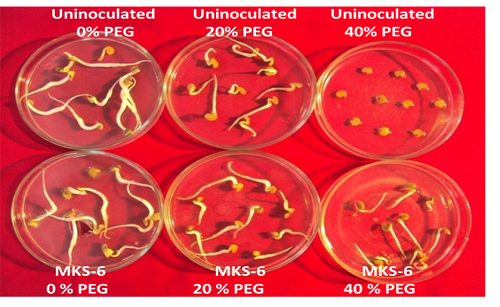Assessment of the Osmotolerant Endophytic Bacteria from Mustard and Nagphani for their Plant Growth Promoting activities under Osmotic stress
Maheshwar Singh Rathi*, Sangeeta Paul, Devender Choudhary, Manoj Kumar, Anil Chandra, Amit C. Kharkwal, Ajit Varma
Research Article | Published: 11 January, 2019
First Page: 130
Last Page: 134
Views: 3560
Keywords: Osmotic stress, Endophytic bacteria, IAA production, GA production, PEG 6000, Exo-polysaccharide, Bacillus casamancensis, Bacillus aryabhattai
Abstract
The present investigation was conducted to determined the effect of osmotic stress on plant growth promoting activities of the osmotolerant endophytic bacteria. Osmotic stress led to a decrease in growth of both the endophytic Bacillus aryabhattai strain NSRSSS-1 and Bacillus casamancensis strain MKS 6. However, supplementation of the medium with 40% PEG 6000 led to drastic reduction in growth of both the cultures. Both endophytic bacterial strains were found to improve seed germination, plumule and radicle length under severe stress conditions. Effect of osmotic stress on plant growth promoting activities of the selected osmotolerant endophytic strains were determined. Both strains were found to possess multiple plant growth promoting activities such as P-solubilization and phytohormone production traits. Osmotic stress had a beneficial effect on P-solubilization, Indole acitic acid and exopolysaccharides production ability of both of the cultures. Osmotic stress had an inhibitory effect on GA production ability of both the cultures. During plant-endophyte association, in vitro conditions, there was an associated decrease in ethylene production by the plant under osmotic stress conditions while IAA, GA and exopolysaccharide production during the plant-endophyte association was significantly enhanced under severe water stress conditions. On the basis of growth at higher PEG concentration, seed germination percentage, plant growth promoting traits and exopolysaccharide production two most promising strains were identified, which can be used as biofertilizers to improve productivity of Cluster bean in arid and semi arid regions of the country.

References
- Borrow A, Brian PW, Chester VE, Curtis PJ and Hemming HG (1955) Gibberellic acid, a metabolic product of the fungus Gibberella fujikuroi. Some observations on its production and isolation. J Sci Fd Agric 6: 340.
- Das B, Paul S and Rathi MS (2017) Effect of osmotic stress on plant growth promoting activities of the osmotolerant endophytic bacteria. Eco. Env. & Cons. 23 (1): 340-344.
- Dimka C, Weinand T and Asch F (2009) Plant-rhizobacteria interactions alleviate abiotic stress conditions. Plant Cell Environ 32 (12): 1682-94.
- Hardy RWF, Holsten RD, Jackson EK and Burn RC (1968) The acetylene-ethylene assay for N2 fixation: Laboratory and field evaluation. Plant Physiol 43: 1185-1207.
- Hartmann A, Singh M, Klingmüller W ( 1983) Isolation and characterization of Azospirillum mutants excreting high amounts of indole acetic acid. Can J Microbiol 29(8) : 916-923.
- Jackson, ML (1967) Soil chemical analysis. Prentice hall of India. pp. 144-145.
- Jackson, M (1997) Hormones from root as signals for the shoots of stressed plants. Elsevier trends j 2: 22-28.
- Kuklinsky-Sobral J, Araújo WL, Mendes R, Geraldi IO, Pizzirani-Kleiner AA and Azevedo JL (2004) Isolation and characterization of soybean associated bacteria and their potential for plant growth promotion. Environ Microbiol 6(12): 1244-1251.
- Magome H, Yamaguchi S, Hanada A, Kamiya Y and Oda K (2004) Dwarf and delayed flowering 1, a novel Arabidopsis mutant deficient in gibberellin biosynthesis because of over expression of a putative AP2 transcription factor. Plant Journal 37(5): 720-729.
- Manjunatha BS, Asha AD, Nivetha N , Bandeppa , Govindasamy V, Rathi MS and Sangeeta P (2017) Evaluation of Endophytic Bacteria for their Influence on Plant Growth and Seed Germination under Water Stress Conditions. Int. J. Curr. Microbiol. App. Sci 6(11): 4061-4067.
- Palaniappan P, Chauhan PS, Saravanan VS, Anandham R and Sa T (2010) Isolation and characterization of plant growth promoting endophytic bacterial isolates from root nodule of Lespedeza sp. Biol Fertility Soils 46(8) : 807-816.
- Rathi MS, Paul S, Manjunatha BS, Kumar V and Varma A (2018) Isolation and Screening of Osmotolerant Endophytic Bacteria from Succulent and Non-Succulent Drought Tolerant plants for water stress alleviation in Cluster Bean (Cyamopsis tetrogonoloba). Vegetos 31(1): 57-66.
- Sabra W, Zeng A, Sabry S, Omar S and Decker W (1999) Effect of phosphate and oxygen concentrations on alginate production and stoichimetry of metabolism of Azotobacter vinelandii under microaerobic conditions. Appl Microbiol Biotechnol 52: 773.
- Taghavi S, Garafola C, Monchy S, Newman Land Hoffman A (2009) Genome survey and characterization of endophytic bacteria exhibiting a beneficial effect on growth and development of poplar trees. Appl Environ Microbiol 75: 748–757.
- Timmusk S, Abd El-Daim IA, Copolovici L, Tanilas Tand Kannaste A (2014) Drought-Tolerance of Wheat Improved by Rhizosphere Bacteria from Harsh Environments: Enhanced Biomass Production and Reduced Emissions of Stress Volatiles. PLoS ONE9(5): e96086.
- Tittabutr P, Piromyou P, Longtonglang A, Noisa-Ngaim R, Boonkerd N and Teaumroong N (2013) Alleviation of the effect of environmental stresses using co-inoculation of mungbean by Bradyrhizobium and rhizobacteria containing stress-induced ACC deaminase enzyme. Soil Sci and Plant Nutrition. 59 (4): 559-571.
- Vurukonda SS, Vardharajula S, Shrivastava M and SkZ A (2016) Enhancement of drought stress tolerance in crops by plant growth promoting rhizobacteria. Microbiol Res 184: 13–24.
- Shahzad R, Khan AL, Bilal S, Asaf S and Lee I-J (2018) What Is There in Seeds? Vertically Transmitted Endophytic Resources for Sustainable Improvement in Plant Growth. Front Plant Sci. 24(9): doi:10.3389/fpls.2018.00024.
Author Information
Division of Microbiology, Indian Agricultural Research Institute, New Delhi- 10012, India.